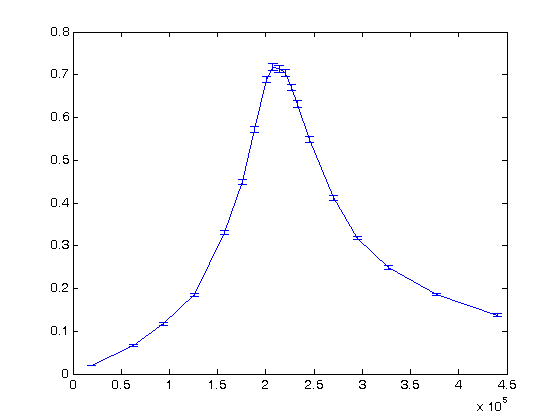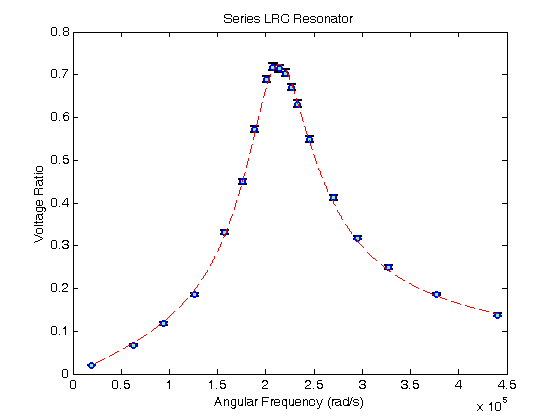% Jake Bobowsk % November 2, 2016 % Created using MATLAB R2014a clearvars % In this script we will fit a nonlinear function to a set of experimental % data. The fit will be weighted by the measurement uncertainties. % In this example, we take data from a series LRC circuit. The the y-axis % we will have the ratio of the magntidue of the voltage across the % resistance to that supplied by the function generator driving the % circuit. On the x-axis we will have frequency. % Enter the data. Vratio= [0.198e-1, 0.67e-1, .117, .185, .331, .450, .573, .689, .718, .714, .704, .670, .631, .549, .412, .318, .249, .186, .138]; length(Vratio) errVratio= [0.1e-2, 0.2e-2, 0.3e-2, 0.3e-2, 0.5e-2, 0.6e-2, 0.7e-2, 0.8e-2, 0.8e-2, 0.8e-2, 0.8e-2, 0.8e-2, 0.8e-2, 0.7e-2, 0.6e-2, 0.4e-2, 0.5e-2, 0.3e-2, 0.3e-2]; length(errVratio) f = [3000, 10000, 15000, 20000, 25000, 28000, 30000, 32000, 33000, 34000, 35000, 36000, 37000, 39000, 43000, 47000, 52000, 60000, 70000]; omega = (2*pi*f); length(omega) % Plot the data with error bars. Use errorbar(x,y,e). errorbar(omega,Vratio,errVratio) % We can format the plot a little more nicely. The 'ko' makes the error % bars black (k) and the point style circles (o). 'MarkerSize',5 sets the % size of the circular points. The ... notation tells MATLAB that the % command continues on the next line. 'LineWidth',1.8 sets the width of the % lines on the circumference of the circular points and those used for the % error bars. The colour inside the circular points is set using % 'MarkerFaceColor' followed by the RGB designation. figure() errorbar(omega,Vratio,errVratio,'ko','MarkerSize',5,... 'LineWidth',1.8,... 'MarkerEdgeColor','b',... 'MarkerFaceColor',[.49 1 .63]); % Axis labels and a plot title can be generated by following you plotting % statement with 'xlabel', 'ylabel' and 'title'. xlabel('Angular Frequency (rad/s)'); ylabel('Voltage Ratio'); title('Series LRC Resonator'); % After completing the fit, we will want to add the best-fit line to our % existing plot. To tell MATLAB to add stuff the the current plot (instead % of creating an entirely new plot), we use 'hold on'. hold on; % Now we define the model that we will fit the data to. This is a bit % tricky until you get used to it... I'm still not used to it. 'b' will % represent a vector of our best-fit parameters. Our model will have three % parameters: the overall amplitude b(1), the width of the resonance b(2), % and the resonance frequency b(3) (really an angular frequency). Our % x-axis data is omega which we previously defined above. Notice that % omega is a list of numbers (or a vector), so to indicate pointwise % operations we have to use dots (.) in from of all the operators (division % and powers in this case). modelfcn=@(b,omega) b(1)./sqrt(1+(omega./b(2)).^2.*(1-(b(3)./omega).^2).^2); % To actually do the nonlinear fit, we use nlinfit. The numbers in within % [ ... ] are the initial guesses for the three parameters b(1), b(2), and % b(3). res = nlinfit(omega,Vratio,modelfcn,[0.7,0.5e5, 2e5]) % After a successful fit, we can isolate the individual parameters and use % them in calculations. For example, the Q or quality factor of the % resonance is given by the ratio of the resonance frequency and the width. amp = res(1); width = res(2); w0 = res(3); Q = w0/width % The above was an unwieghted fit and there were no error estimates for the % best-fit parameters. Typically, a fit is weighted by one over the square % of the uncertainties. In this way, points with large error bars don't % contribute to the fitting routine as much as points with small error % bars. First, we define our weights: w=power(errVratio,-2); % We use fitnlm for the weighted fit. fit=fitnlm(omega,Vratio,modelfcn,[0.72,0.65e5, 2.1e5],'Weights',w) % Handling the output of fitnlm is a bit nonintuitive. We can access the % table using fit.Coefficients: fit.Coefficients % We can also get a specific column: fit.Coefficients.Estimate fit.Coefficients.SE % We can also get specific elements of a specific column and then use them % in a calculation. width = fit.Coefficients.Estimate(2); errWidth = fit.Coefficients.SE(2); w0 = fit.Coefficients.Estimate(3); errw0 = fit.Coefficients.SE(3); Q = w0/width errQ = sqrt((errw0/width)^2+(w0*errWidth/width^2)^2) % We defind our best-fit model as a function (modelfcn). It's time to use % it again. modelfcn takes as arguments a vector of three best-fit % parameters (which we access using fit.Coefficients.Estimate) and values % of omega. So for example, if we wanted to know the best-fit value of the % model at omega = 2*pi*15 kHz, we would enter: modelfcn(fit.Coefficients.Estimate,2*pi*15e3) % Really, we want to plot the best-fit curve. To do that, we use linspace % to make vector of many omega values within the range of interest. Below, % we make a omega vector xx with 5000 points between the minimum and % maximum experimental values of omega. We then calculate the best-fit % y-values at all those omega values and plot the results. Because we used % 'hold on' previously, the best-fit line will be added to the plot that we % generated earlier. In the plot statement '--r' means make the line % dashed and colour it red. xx = linspace(min(omega),max(omega),5000); % bunch of x values yy = modelfcn(fit.Coefficients.Estimate,xx); plot(xx,yy,'--r'); %Finally, set set 'hold off' so that next time we make a plot it will start %from scratch. hold off;
ans =
19
ans =
19
ans =
19
res =
1.0e+05 *
0.0000 0.6802 2.1326
Q =
3.1350
fit =
Nonlinear regression model:
y ~ b1/sqrt(1 + (omega/b2)^2*(1 - (b3/omega)^2)^2)
Estimated Coefficients:
Estimate SE tStat pValue
__________ _________ ______ __________
b1 0.72432 0.0063279 114.46 9.6253e-25
b2 66817 1080.8 61.822 1.7952e-20
b3 2.1388e+05 538.8 396.94 2.2184e-33
Number of observations: 19, Error degrees of freedom: 16
Root Mean Squared Error: 1.73
R-Squared: 0.999, Adjusted R-Squared 0.999
F-statistic vs. zero model: 1.04e+04, p-value = 1.64e-26
ans =
Estimate SE tStat pValue
__________ _________ ______ __________
b1 0.72432 0.0063279 114.46 9.6253e-25
b2 66817 1080.8 61.822 1.7952e-20
b3 2.1388e+05 538.8 396.94 2.2184e-33
ans =
1.0e+05 *
0.0000
0.6682
2.1388
ans =
1.0e+03 *
0.0000
1.0808
0.5388
Q =
3.2009
errQ =
0.0524
ans =
0.1220

